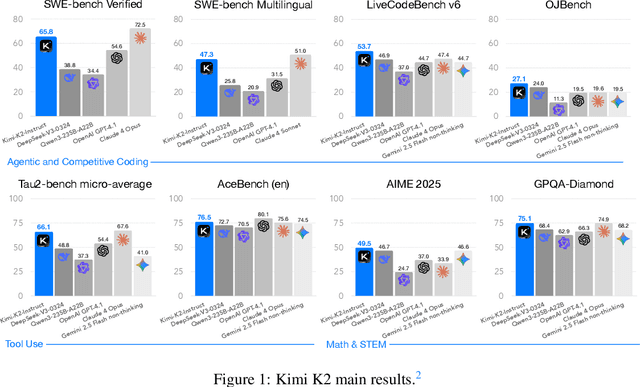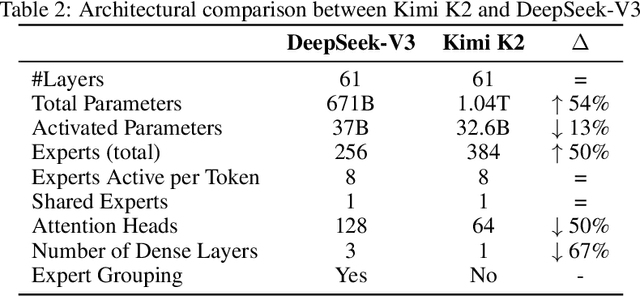Wenyang He
Kimi K2: Open Agentic Intelligence
Jul 28, 2025



Abstract:We introduce Kimi K2, a Mixture-of-Experts (MoE) large language model with 32 billion activated parameters and 1 trillion total parameters. We propose the MuonClip optimizer, which improves upon Muon with a novel QK-clip technique to address training instability while enjoying the advanced token efficiency of Muon. Based on MuonClip, K2 was pre-trained on 15.5 trillion tokens with zero loss spike. During post-training, K2 undergoes a multi-stage post-training process, highlighted by a large-scale agentic data synthesis pipeline and a joint reinforcement learning (RL) stage, where the model improves its capabilities through interactions with real and synthetic environments. Kimi K2 achieves state-of-the-art performance among open-source non-thinking models, with strengths in agentic capabilities. Notably, K2 obtains 66.1 on Tau2-Bench, 76.5 on ACEBench (En), 65.8 on SWE-Bench Verified, and 47.3 on SWE-Bench Multilingual -- surpassing most open and closed-sourced baselines in non-thinking settings. It also exhibits strong capabilities in coding, mathematics, and reasoning tasks, with a score of 53.7 on LiveCodeBench v6, 49.5 on AIME 2025, 75.1 on GPQA-Diamond, and 27.1 on OJBench, all without extended thinking. These results position Kimi K2 as one of the most capable open-source large language models to date, particularly in software engineering and agentic tasks. We release our base and post-trained model checkpoints to facilitate future research and applications of agentic intelligence.
Athena: Efficient Block-Wise Post-Training Quantization for Large Language Models Using Second-Order Matrix Derivative Information
May 24, 2024Abstract:Large Language Models (LLMs) have significantly advanced natural language processing tasks such as machine translation, text generation, and sentiment analysis. However, their large size, often consisting of billions of parameters, poses challenges for storage, computation, and deployment, particularly in resource-constrained environments like mobile devices and edge computing platforms. Effective compression and quantization techniques are crucial for addressing these issues, reducing memory footprint and computational requirements without significantly compromising performance. Traditional methods that uniformly map parameters to compressed spaces fail to account for the uneven distribution of parameters, leading to substantial accuracy loss. In this work, we propose Athena, a novel algorithm for efficient block-wise post-training quantization of LLMs. Athena leverages Second-Order Matrix Derivative Information to guide the quantization process using the curvature information of the loss landscape. By grouping parameters by columns or rows and iteratively optimizing the quantization process, Athena updates the model parameters and Hessian matrix to achieve significant compression while maintaining high accuracy. This makes Athena a practical solution for deploying LLMs in various settings.
AttentionLego: An Open-Source Building Block For Spatially-Scalable Large Language Model Accelerator With Processing-In-Memory Technology
Jan 21, 2024Abstract:Large language models (LLMs) with Transformer architectures have become phenomenal in natural language processing, multimodal generative artificial intelligence, and agent-oriented artificial intelligence. The self-attention module is the most dominating sub-structure inside Transformer-based LLMs. Computation using general-purpose graphics processing units (GPUs) inflicts reckless demand for I/O bandwidth for transferring intermediate calculation results between memories and processing units. To tackle this challenge, this work develops a fully customized vanilla self-attention accelerator, AttentionLego, as the basic building block for constructing spatially expandable LLM processors. AttentionLego provides basic implementation with fully-customized digital logic incorporating Processing-In-Memory (PIM) technology. It is based on PIM-based matrix-vector multiplication and look-up table-based Softmax design. The open-source code is available online: https://bonany.cc/attentionleg.
 Add to Chrome
Add to Chrome Add to Firefox
Add to Firefox Add to Edge
Add to Edge